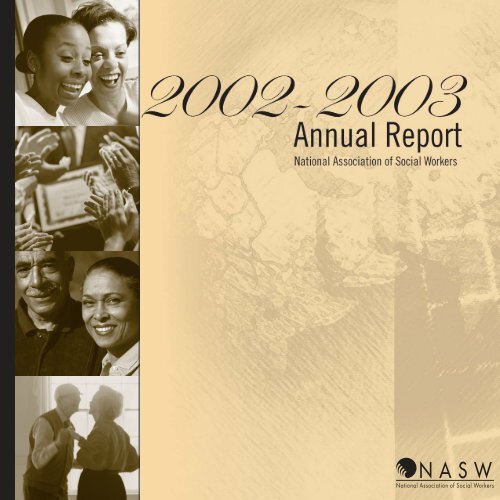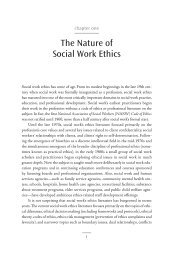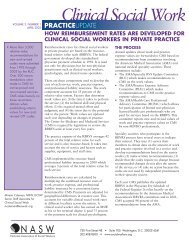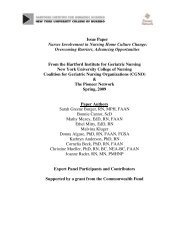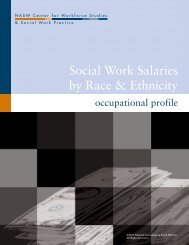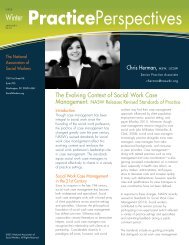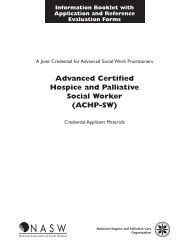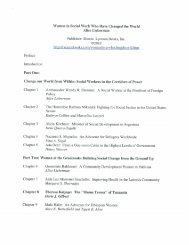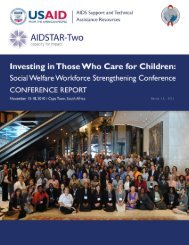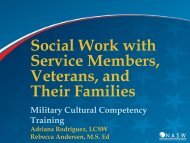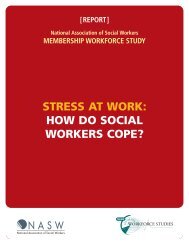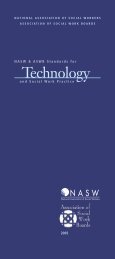Download - National Association of Social Workers
Download - National Association of Social Workers
Download - National Association of Social Workers
- No tags were found...
Create successful ePaper yourself
Turn your PDF publications into a flip-book with our unique Google optimized e-Paper software.
<strong>National</strong> <strong>Association</strong> <strong>of</strong> <strong>Social</strong> <strong>Workers</strong>Mission StatementNASW is a membership organizationwith a dual mission to:•Promote, develop, and protect thepractice <strong>of</strong> social work and socialworkers; and• Seek to enhance the effective functioningand well-being <strong>of</strong> individuals, families,and communities through its work andthrough its advocacy.Created in 1955 through a merger <strong>of</strong>seven social work organizations, the<strong>National</strong> <strong>Association</strong> <strong>of</strong> <strong>Social</strong> <strong>Workers</strong> isthe largest membership organization <strong>of</strong>pr<strong>of</strong>essional social workers in the world.The <strong>Association</strong> is comprised <strong>of</strong> morethan 150,000 members, who are requiredto agree to and sign the NASW Code <strong>of</strong>Ethics upon joining.NASW’s 56 chapters consist <strong>of</strong> thefollowing: 50 state chapters, aninternational chapter, and five additionalchapters in Guam, New York City,Puerto Rico, the Virgin Islands, andWashington, D.C.©2004 <strong>National</strong> <strong>Association</strong> <strong>of</strong> <strong>Social</strong> <strong>Workers</strong>. All Rights Reserved.
Table <strong>of</strong> ContentsLetter from Executive Director and President ......................................................................2Board <strong>of</strong> Directors ................................................................................................................4Meetings and Conferences ..................................................................................................6Advocating for <strong>Social</strong> Change and Representation ..............................................................8Supporting Vital <strong>Social</strong> Work Education and Research ......................................................10Supporting <strong>Social</strong> Justice Through Legal Advocacy............................................................11Advancing NASW Programs at State and Local Levels ......................................................12Ensuring Quality <strong>of</strong> Care....................................................................................................14Promoting and Protecting <strong>Social</strong> Work Practice ................................................................16Informing <strong>Social</strong> <strong>Workers</strong>, Enhancing Care ........................................................................18Building Knowledge About <strong>Social</strong> Work Practice ................................................................19The NASW Legal Defense Fund: Helping Those Who Help Others........................................20NASW in the News..............................................................................................................21Updating the <strong>Association</strong>’s Image......................................................................................22Providing Value and Excellent Service to Our Members ....................................................22Linking <strong>Social</strong> <strong>Workers</strong> With <strong>Social</strong> Work Employers ..........................................................23NASW Press: Informing <strong>Social</strong> <strong>Workers</strong> and the World........................................................24Financial Information ........................................................................................................26
Letter from theNASW Presidentand ExecutiveDirectorThere is a common misconception that the only people whose lives are touched by social workers are welfarerecipients and abused or neglected children. While these are critical and valuable aspects <strong>of</strong> social work,this belief is far from the truth. In fact, at one time or another, social workers—uniquely trained andpositioned to address a huge array <strong>of</strong> issues and problems ranging in scale from global to individual—touch each <strong>of</strong> our lives.Many people encounter social workers as they help older parents or loved ones move into nursing or assistedliving facilities. Others benefit from therapy they receive from social workers in private or group practices.There are social workers on Capitol Hill, shaping policies and voting on legislation affecting every one <strong>of</strong> us.<strong>Social</strong> workers provide hope and help, employing a holistic approach that considers all aspects <strong>of</strong> a person:biological, psychological, spiritual, and social. Our role at NASW is to support and advance this crucialpr<strong>of</strong>ession, while helping promote and enhance the quality <strong>of</strong> life for those served by social workers.Through increased membership, NASW has continued to gain influence with legislators and policymakers, andhas garnered well-earned respect among pr<strong>of</strong>essional social workers, social work educators, and social workemployers around the world. Over the past year, the <strong>Association</strong>’s membership increased by more than 4,000.This substantial growth is especially meaningful since, due to the economic climate, very few otherpr<strong>of</strong>essional associations have reported similar increases. And we are confident that our numbers willcontinue to rise throughout the coming year.Collaborations and memoranda <strong>of</strong> understanding with other social work organizations not only help to betterposition NASW to promote its mission, but also to build strength and unity among social workers. In December2002, NASW convened <strong>Social</strong> Work Summit II, attended by more than 68 leaders representing 42 nationalsocial work organizations. Through the exchange <strong>of</strong> ideas and experiences, we moved one step closer towardour goal <strong>of</strong> building greater influence for the social work pr<strong>of</strong>ession.NASW continues to make significant contributions in the areas <strong>of</strong> social work research, practice, and advocacy.In addition to active participation in several high-pr<strong>of</strong>ile court cases and ongoing government relations andlegislative efforts, NASW’s Blue Ribbon Panel on Economic Security commissioned and published a series <strong>of</strong>papers supporting the <strong>Association</strong>’s position on Temporary Aid for Needy Families (TANF) reauthorization.NASW is now embarking on what may be the most exciting and challenging year in the <strong>Association</strong>’s history.We have taken the initial steps toward implementing a multimedia, multiyear <strong>Social</strong> Work Public EducationCampaign, and are currently conducting opinion research to determine the most effective ways to educatethe public, business, and academic sectors about the realities, importance, and value <strong>of</strong> social work.2Gary Bailey, MSWPresidentElizabeth J. Clark, PhD, ACSW, MPHExecutive Director
Board <strong>of</strong> Directors4Gary Bailey, MSWPresidentAssociate Pr<strong>of</strong>essorSimmons College GraduateSchool <strong>of</strong> <strong>Social</strong> WorkMassachusettsStacie Hiramoto, MSWVice PresidentHuman Services Program PlannerSacramento County Division<strong>of</strong> Mental HealthCaliforniaElvira Craig de Silva, DSW, ACSWSecond Vice PresidentAssociate DeanWaukesha CountyTechnical CollegeWisconsinEsther Jones Langston, PhD,ACSW, LCSWSecretaryDirector, School <strong>of</strong> <strong>Social</strong> WorkUniversity <strong>of</strong> Nevada, Las VegasNevadaPaul A. D’Agostino, ACSW, LCSWTreasurerExecutive DirectorChild Abuse CouncilFloridaMary F. Hall, PhD, ACSW, LICSWAssociate Pr<strong>of</strong>essorSmith College School <strong>of</strong><strong>Social</strong> WorkMassachusettsMarion J. Fontanella, LCSWVice President, Program ServicesKlingberg Family CentersConnecticutMaria Sunukjian, MSWExecutive DirectorFamily and Child Service<strong>of</strong> Schenectady, Inc.New YorkDawn Hall Apgar, PhD, ACSW, LSWDirector, DevelopmentalDisabilities Planning InstituteNew Jersey Institute <strong>of</strong> TechnologyNew JerseyJanet Burton, DSW, LICSW, DCSWDirector and Pr<strong>of</strong>essor,<strong>Social</strong> Work ProgramUniversity <strong>of</strong> the District <strong>of</strong> ColumbiaDistrict <strong>of</strong> ColumbiaAnne M. Brennan, ACSW(Deceased)Former Director <strong>of</strong> Child WelfareCatholic Charities <strong>of</strong> MiamiFloridaRebecca A. Cline, LISWD.E.L.T.A. Project CoordinatorOhio Domestic Violence NetworkOhioJacqueline Steingold, ACSW, CSWAdjunct Faculty, Wayne StateUniversityMichiganDiana R. Stroud, ACSW, LCSW, DCSWAssociate Dean, Developmentand Alumni Relations, School<strong>of</strong> <strong>Social</strong> WorkUniversity <strong>of</strong> Illinois atUrbana-ChampaignIllinoisJames H. Townsend, ACSW, MHASenior Vice PresidentManagement Services OrganizationAmeriChoiceArizonaAdelaida Montemayor, LMSW-ACPClinical <strong>Social</strong> WorkerLubbock Independent School DistrictTexasAlicia Smalley, MSWDirector, Field InstructionSchool <strong>of</strong> <strong>Social</strong> WorkUniversity <strong>of</strong> Nevada, RenoNevadaCatharine J. Ralph, MSW, LCSW,PPSCField Consultant/LecturerSchool <strong>of</strong> <strong>Social</strong> WelfareUniversity <strong>of</strong> California, BerkeleyCaliforniaYvette Colón, ACSW, BCDDirector <strong>of</strong> Education andInternet ServicesAmerican Pain FoundationMarylandJoanne E. Cruz Tenery, MSSW,LMSWManager, Member RelationsParkland Health andHospital SystemTexasPhyllis J. Edwards, MSWFamily Independence Manager/<strong>Social</strong> Services Program ManagerState <strong>of</strong> Michigan, Child andFamily ServicesMichiganJamie SimonsBSW Student MemberCalifornia State University, ChicoCaliforniaNorma Viola Cantú, MSWMSW Student Member(Graduated, May 2003)Eastern Michigan UniversityMichigan
NASW is nowembarking onwhat may bethe most excitingand challengingyear in the<strong>Association</strong>’shistory.5
Meetings and Conferences…ANNUAL LEADERSHIP MEETING – JULY 2003Chapter presidents, executives, and board members traveled to Washington, D.C. to meet with national staffleaders to discuss the state <strong>of</strong> the <strong>Association</strong>, exchange strategies for social work advocacy, and participatein training seminars at the Annual Leadership Meeting.The Plenary Session included a state-<strong>of</strong>-the-<strong>Association</strong> address by Executive Director Elizabeth J. Clark,during which she discussed NASW’s increasing membership (an anomaly for membership organizationsduring a slow economy); the highlights <strong>of</strong> <strong>Social</strong> Work Summit II; memoranda <strong>of</strong> understanding signed withfour organizations (Canadian <strong>Association</strong> <strong>of</strong> <strong>Social</strong> <strong>Workers</strong>, School <strong>Social</strong> <strong>Workers</strong> <strong>of</strong> America, <strong>Association</strong>for the Advancement <strong>of</strong> <strong>Social</strong> Work with Groups, and the <strong>National</strong> Network for <strong>Social</strong> Work Managers); the<strong>Association</strong>’s continuing work in developing and maintaining standards <strong>of</strong> social work practice in severalspecialty areas; and the launch <strong>of</strong> the new NASW Web site design.ALM this year also included keynote speaker NaomiHaines Griffith, social worker and author <strong>of</strong> Red Clayand Vinegar; featured speakers Charles Curie, NASWmember and administrator <strong>of</strong> the federal SubstanceAbuse and Mental Health Services Administration, JillManske, director <strong>of</strong> social work service with theVeterans Health Administration, and Julia M. Watkins,new executive director <strong>of</strong> the Council on <strong>Social</strong> WorkEducation; and a welcome address from newly sworninNASW President Gary Bailey,who stated, “<strong>Social</strong> justice isthe soul <strong>of</strong> social work. It’swhat makes us different fromother pr<strong>of</strong>essions, and is thecornerstone <strong>of</strong> our <strong>Association</strong>.”ALM was also the venue forthe national NASW and NASWFoundation awards; presentation<strong>of</strong> the Chapter ExecutiveDirector <strong>of</strong> the Year award;and the Gilman-Wells Awardfor a chapter staff memberdemonstrating excellencein a particular area.6
DELEGATE ASSEMBLY – AUGUST 2002Delegate Assembly (DA) is the representative decision making body through which the <strong>Association</strong>’smembers set broad organizational policy, establish program priorities, and develop a collective stance onpublic and pr<strong>of</strong>essional issues.The 2002 DA adopted amendments to NASW’s bylaws that will have an impact on future DelegateAssemblies, the Board <strong>of</strong> Directors, and the Committee on Inquiry.Additionally, the Assembly adopted several new policy statements, including:• Capital Punishment and the Death Penalty• Crime Victim Assistance• Invest in Adolescent Health• Rural <strong>Social</strong> Work• School Violence• Sovereignty and Health <strong>of</strong> Indigenous PeopleThese statements were included in the January 2003 edition <strong>of</strong> <strong>Social</strong> Work Speaks,available from NASW Press. Abstracts <strong>of</strong> NASW’s policy statements are available online atwww.socialworkers.org/resources/abstracts/default.aspThe DA also adopted resolutions on a variety <strong>of</strong> topics that reflect and express the will or intent <strong>of</strong> theAssembly regarding emerging issues. The 2002 DA created changes for the future that will allow for the<strong>Association</strong>’s—and the pr<strong>of</strong>ession’s—continued growth and advancement.SOCIAL WORK SUMMIT II – DECEMBER 2002For two days in December 2002, more than 68 leaders representing 42 national social work organizationsparticipated in <strong>Social</strong> Work Summit II, which focused on:“Building a positive image and greater influence for the social work pr<strong>of</strong>ession through social workadvocacy, practice, education, and research.”From the many issues discussed, three organizing themes emerged:• The need to clearly define the pr<strong>of</strong>ession and demonstrate the economic value <strong>of</strong>pr<strong>of</strong>essional social workers to society and employers;• The need to strategically communicate to the public, media, legislators, and employersthe importance <strong>of</strong> social work practice to society; and• The need to build and nurture an effective inter-organizational coalition that promotesshared priorities and mobilizes the organizations’ collective memberships into actionaround common issues and concerns.As participants exchanged ideas and experiences, obtained resources for their organizations, and identifieda proactive agenda for strengthening the pr<strong>of</strong>ession, the Summit generated a renewed sense <strong>of</strong> partnershipand collaboration among key social work groups.7
Advocating for <strong>Social</strong> Change and Representation…NASW is concerned about a range <strong>of</strong> issues affecting the quality <strong>of</strong> life for people nationally and internationally,and the ability <strong>of</strong> pr<strong>of</strong>essional social workers to provide quality services. During 2002-2003, the <strong>Association</strong>focused its legislative advocacy on a variety <strong>of</strong> areas, including health and mental health, child welfare,economic security, equity, civil rights, education, and social work research.PARTICIPATING IN THE ELECTORAL PROCESS…NASW’s Political Action for Candidate Election (PACE) staff work to organize social work pr<strong>of</strong>essionals forparticipation in yearly elections and to represent the values <strong>of</strong> the pr<strong>of</strong>ession through legislative andregulatory advocacy.Among other activities associated with the electoral process, NASW participated in the 2002 mid-termelection by:•Training, deploying, and financing field organizers in Arkansas, Iowa, Illinois, Louisiana, Minnesota,Missouri, and North Carolina• Implementing a field organizer’s program, which contained a special outreach component to socialwork students and educators, including presentations to 88 classes at 59 schools, reaching more than2,500 students•Providing voter registration service on the NASW Web site• Contributing $222,000 to 90 congressional candidates—18 Senators and 72 Representatives amongthem—including four social workers running for re-election to the U.S. House <strong>of</strong> RepresentativesAt the end <strong>of</strong> the 2002 electoral cycle, 75 percent <strong>of</strong> the candidates supported by NASW through thePolitical Action Committee had been elected.FOCUSING ON THE NEEDS OF INDIVIDUALS, FAMILIES, AND COMMUNITIES…The <strong>Association</strong> strives to promote the well-being <strong>of</strong> individuals, families, and communities and representsthe values <strong>of</strong> the social work pr<strong>of</strong>ession through legislative and regulatory advocacy, focusing its effortson such issues as:• Mental health parity•Temporary Aid for Needy Families (TANF) reform• Medicare prescription benefits• Child welfare• Civil rights• Racial pr<strong>of</strong>iling/hate crimes• Individuals with Disabilities Education Act reauthorizationTogether with staff members from the <strong>Association</strong>’s Program, Policy & Practice department, GovernmentRelations experts also participated in advocacy efforts with policymakers and reimbursement entities to worktoward higher reimbursement rates for social workers.8
Supporting Vital <strong>Social</strong> Work Education and Research…ACTION NETWORK FOR SOCIAL WORK EDUCATION AND RESEARCH (ANSWER)ANSWER is a coalition whose mission is to increase legislative and executive branch advocacy on behalf <strong>of</strong>social work education, training, and research. This goal is accomplished through collaboration amongsocial work education, research, and practice programs, and other interested groups. Together with NASW,the following groups currently participate in the coalition:• <strong>Association</strong> <strong>of</strong> Baccalaureate <strong>Social</strong> Work Program Directors (BPD)• Council on <strong>Social</strong> Work Education (CSWE)•Group for the Advancement <strong>of</strong> Doctoral Education (GADE)• Institute for the Advancement <strong>of</strong> <strong>Social</strong> Work Research (IASWR)• <strong>National</strong> <strong>Association</strong> <strong>of</strong> Deans and Directors <strong>of</strong> Schools <strong>of</strong> <strong>Social</strong> Work (NADD)• Society for <strong>Social</strong> Work and Research (SSWR)Since March 2002, NASW has been responsible for carrying out ANSWER’s lobbying priorities and staffingANSWER’s steering committee.• During the past year, on behalf <strong>of</strong> ANSWER, NASW: staffed and hosted two meetings <strong>of</strong> the ANSWERsteering committee; built a Web site for ANSWER; maintained ANSWER’s presence on the NASW Web site;staffed and hosted a lobby day at the SSWR conference; provided ANSWER updates to practitionersthrough NASW’s Web site; and briefed educators at annual CSWE, NADD, and GADE meetings.Also, NASW represents the ANSWER coalition by advocating for the <strong>National</strong> Center for <strong>Social</strong> Work Research Act(NCSWRA), and re-introduced NCSWRA in the 108th Congress (as S.73/H.R.844).MOBILIZING MEMBERS FOR POLITICAL ACTIONNASW participates in a variety <strong>of</strong> activities to incorporate NASW members into the <strong>Association</strong>’s work inways that: (1) are meaningful to members; and (2) advance NASW’s legislative and political goals. Theseactivities include:• Mobilizing social workers for legislative and electoral policy campaigns• Planning federal lobby days•Working with chapter staff to engage members in lobbying activities•Providing outreach to social work educators and students•Co-staffing the <strong>Social</strong> Work Council and ANSWER coalitions• Planning events between NASW Government Relations/PACE staff and social workers on Capitol Hill• Supervising PACE field organizers• Assisting with get-out-the-vote activities10
Supporting <strong>Social</strong> Justice Through Legal Advocacy…NASW participates in legal action where criticalsocial policy, social justice, or pr<strong>of</strong>essional socialwork issues are at stake, as part <strong>of</strong> its mission toenhance the effective functioning and well-being<strong>of</strong> individuals, families, and communities throughadvocacy.This year, NASW filed nine “friend <strong>of</strong> thecourt” (amicus) briefs, listed below, effectivelyparticipating in cases <strong>of</strong> vital importance tosocial workers and those they serve:Gratz v. Bollinger & Grutter v. Bollinger, UnitedStates Supreme Court, 2003—Brief filed insupport <strong>of</strong> University <strong>of</strong> Michigan’s use <strong>of</strong>affirmative action principles in law andundergraduate admissionsWiggins v. Smith, United States Supreme Court, 2003—Brief filed in support <strong>of</strong> Maryland man sentenced todeath whose attorney failed to present a psychosocial evaluationLawrence & Garner v. State <strong>of</strong> Texas, United States Supreme Court, 2003—Brief filed in favor <strong>of</strong> strikingdown Texas same-sex sodomy law as unconstitutionalOverton v. Bazetta, United States Supreme Court, 2003—Brief filed in favor <strong>of</strong> repealing MichiganDepartment <strong>of</strong> Corrections limits on rights <strong>of</strong> children to visit parents and close relatives in prisonCity <strong>of</strong> Chicago v. Beretta USA Corporation, Illinois Appellate Court, 2003—Brief filed in support <strong>of</strong> City<strong>of</strong> Chicago claim that gun manufacturer’s sales and marketing practices constituted a public nuisanceSharon S. v. Superior Court <strong>of</strong> San Diego County, California Supreme Court, 2002—Brief filed in support<strong>of</strong> lesbian second parent adoption in CaliforniaJegley v. Picado, Arkansas Supreme Court, 2002—Brief filed in favor <strong>of</strong> striking down Arkansas same-sexsodomy law as unconstitutionalIn re Bonfield, Ohio Supreme Court, 2002—Brief filed in support <strong>of</strong> lesbian couple to create equal-parentingrights for their childrenIn re Maloney, Ohio Supreme Court, 2002—Brief filed in support <strong>of</strong> transgendered woman’s right to changeher first name11
Advancing NASW Programs at State and Local Levels…The heart and soul <strong>of</strong> NASW are its 56 chapters, which advance the <strong>Association</strong>’s programs and plans at thestate and local levels, with special emphasis on the needs and interests <strong>of</strong> their particular members.Each year, NASW’s chapters embark on a variety <strong>of</strong> programs and host a broad range <strong>of</strong> events that areessential to the success <strong>of</strong> the <strong>Association</strong> as a whole. The following three examples illustrate the importantwork being done by NASW chapters across the nation and around the world…NASW – TEXASWith more than 5,600 members and 21 branches, the Texas Chapter plays a tremendous role in advocatingfor—and representing—pr<strong>of</strong>essional social workers.Under the leadership <strong>of</strong> President T. Paul Furukawa, PhD, ACSW, and Executive Director Vicki Hansen,LMSW-AP, the Texas Chapter launched a public education campaign in 2002, to:• Educate the public about social workers;• Build consumer demand for social work services; and• Recruit students into the pr<strong>of</strong>ession.Among the activities and strategies employed in its public education campaign, the Texas Chapter developedpublic service announcements (PSAs) that have run on radio stations across the state; television commercials(also PSAs), which several television stations have pledged to run; and statewide billboard advertising.The campaign motto—featured in the public service announcements—is “<strong>Social</strong> <strong>Workers</strong>: People HelpingPeople, That’s What We Do!” The Chapter created the motto based on the concept that many people areconfused about what social workers do, according to Hansen. She noted that “People Helping People” is a truthcommon to all social workers, one that she hopes the campaign will “implant in people’s minds.”12
NASW – NEVADANASW’s Nevada Chapter, under the leadership <strong>of</strong> President James Euler, ACSW, and Executive Director MarkNichols, is one <strong>of</strong> about 15 progressive organizations in the state that joined together to found, and support thesuccessful launch <strong>of</strong>, Nevada News Services (NNS), which provides mainstream news outlets with high-qualityradio stories to lift up <strong>of</strong>ten-marginalized voices and perspectives.Rex Gunderson—the spouse <strong>of</strong> an NASW student member, a lifelong broadcaster, and most recently the localhost <strong>of</strong> Public Radio’s Morning Edition in northern Nevada—was hired as the NNS producer. His stories forNNS are distributed to radio news directors across the state, and broadcasters can download sound bitesfrom the Internet.NNS provides a progressive perspective to news stories, which likely would not have been covered by themedia prior to its formation. Statewide, 25 radio stations aired a recent story about Domestic ViolenceAwareness Month at least twice. Other NNS stories that help convey a social work perspective to the publicinclude: “Number <strong>of</strong> Nevadans Living in Poverty Continues to Increase,” “Immigrant <strong>Workers</strong> Freedom RideComes to Nevada,” “Nevada Working Women are Losing Safety Net,” “Gay Pride Celebration in Reno,” and“Human Trafficking in Nevada.”NASW – MAINEFollowing several years <strong>of</strong> study, generating support, and lobbying state legislators, the Maine Chapter realizedthe rewards <strong>of</strong> all <strong>of</strong> their work with passage <strong>of</strong> a comprehensive Mental Health Parity Act in Spring 2003.Enacting legislation that would bring mental health coverage onto an equal footing with medical disordershad long been a priority for the Maine Chapter. Although the State <strong>of</strong> Maine has had partial parity since themid-1990s, it was limited to a few diagnoses. With passage <strong>of</strong> the new law, coverage is available for alldiagnostic categories, with no separate conditions that limit coverage, and includes a requirement forhome-based services.Commenting on passage <strong>of</strong> the landmark legislation, Maine Chapter Executive Director Kimm A. Collins,MSW, and President Kim-Anne Perkins, MSW, noted the chapter received significant support from alliedorganizations in moving the legislation forward and ultimately gaining passage and the Governor’s signature.For more information about the innovative programs sponsored by all 56 NASW chapters, visit theNASW Web site at www.socialworkers.com, where you will find the full NASW Annual Report,and from which you can link to individual chapter Web sites.13
Ensuring Quality <strong>of</strong> Care…SUPPORTING STANDARDS OF SOCIAL WORK PRACTICECredentialing and certifying pr<strong>of</strong>essional social workers is an essential part <strong>of</strong> NASW’s work, with ramificationsthat extend well beyond our mission <strong>of</strong> advancing the pr<strong>of</strong>ession. The <strong>Association</strong>’s standards help ensure thateveryone who receives assistance from a certified, credentialed social worker receives the highest possible level<strong>of</strong> service.Additionally, NASW believes it is important to more clearly define the term “social worker,” so that the public,social work employers, the media, and policymakers can better understand the pr<strong>of</strong>ession and its vitalcontributions to people in nearly every sector <strong>of</strong> society. NASW’s certification and credentialing programs areone step in this crucial process.The NASW Credentialing Center establishes and promotes the standards and credentials required forexcellence in the practice <strong>of</strong> social work. The Center administers the following credentials, in order toenable social workers to support high standards <strong>of</strong> social work practice and to demonstrate commitmentto ethical and competent practice:• Academy <strong>of</strong> Certified <strong>Social</strong> <strong>Workers</strong> (ACSW)• Qualified Clinical <strong>Social</strong> Worker (QCSW)• Diplomate in Clinical <strong>Social</strong> Work (DCSW)INCREASING THE VISIBILITY OF CLINICAL SOCIAL WORKERSNASW continues to help people locate the clinical social workers who best suit their needs—and to feelconfident that the social workers they contact are among the ranks <strong>of</strong> the pr<strong>of</strong>ession’s most highlyeducated and thoroughly trained pr<strong>of</strong>essionals.Finding the right social worker is as easy as a click <strong>of</strong> the mouse since NASW developed the Register <strong>of</strong> Clinical<strong>Social</strong> <strong>Workers</strong>, a bi-annual publication that serves as the primary source for social work referral information.The NASW Register <strong>of</strong> Clinical <strong>Social</strong> <strong>Workers</strong>:• Lists clinical social workers at two levels <strong>of</strong> experience and expertise: Qualified Clinical <strong>Social</strong> Worker(QCSW) and Diplomate in Clinical <strong>Social</strong> Work (DCSW);•Provides a listing <strong>of</strong> clinical social workers who have met national standards for education andexperience established by the NASW Competence Certification Commission;• Serves as verification <strong>of</strong> the credentials and education <strong>of</strong> every individual listed;•Provides a listing <strong>of</strong> clinical social workers who meet verified uniform national pr<strong>of</strong>essional criteria; and• Facilitates improved inter- and intra-pr<strong>of</strong>essional referrals and consultations to accommodateindividualized treatment planning sensitive to diagnosis, preferred treatment modality, cultural issues,and geographical locations.14
The 2003 Register <strong>of</strong> Clinical <strong>Social</strong> <strong>Workers</strong>, 12th Edition, includes listings for 6,433 clinical social workers,representing virtually all <strong>of</strong> NASW’s chapters.The Register is available free for online searchers to find qualified clinical social workers, providing aninvaluable service to the mental health community and the public.In addition to the Register, the Credentialing Department also published the 2003 Third-PartyReimbursement for Clinical <strong>Social</strong> Work Services.CERTIFYING SOCIAL WORKERS WITH SPECIAL EXPERTISEClients, employers, and colleagues can <strong>of</strong>ten benefit from knowing “at a glance” when they have locateda social worker with expertise in a specific area <strong>of</strong> practice.In response to a clearly identified need and interest, NASW created several Specialty Certifications,national certification programs in areas <strong>of</strong> social work specialization, including:• Certified Clinical Alcohol, Tobacco, and Other Drugs <strong>Social</strong> Worker (C-CATODSW)• Certified School <strong>Social</strong> Work Specialist (C-SSWS)• Certified Advanced <strong>Social</strong> Work Case Manager (C-ASWCM)• Certified <strong>Social</strong> Work Case Manager (C-SWCM)This year, NASW added the following three new specialty certifications to its existing programs:• Certified Advanced Children, Youth, and Family <strong>Social</strong> Worker (C-ACYFSW)• Certified Children, Youth, and Family <strong>Social</strong> Worker (C-CYFSW)• Certified <strong>Social</strong> Worker in Health Care (C-SWHC)In addition to helping the public identify social workers who specialize in specific areas <strong>of</strong> practice, thesecertifications help NASW members attain enhanced pr<strong>of</strong>essional and public recognition; increased visibility;and association with a select group <strong>of</strong> specialized social workers who have attained national distinction.They are not a substitute for state licenses.ENSURING QUALITY OF CONTINUING EDUCATIONThe <strong>National</strong> <strong>Association</strong> <strong>of</strong> <strong>Social</strong> <strong>Workers</strong> (NASW) <strong>of</strong>fers formal social workcontinuing education (CE) approval for programs that meet its criteria. Theseeducational <strong>of</strong>ferings may be used by social workers to meet CE requirements forsocial work licensure/certification renewal. To date, more than 35 state licensingboards have accepted the NASW CE Approval program.The CE Approval program <strong>of</strong>fers a variety <strong>of</strong> courses that will help members whocurrently hold one <strong>of</strong> NASW’s specialty certifications to satisfy their CE requirements for certification renewal.15
Promoting and Protecting <strong>Social</strong> Work Practice…One <strong>of</strong> the goals <strong>of</strong> the <strong>National</strong> <strong>Association</strong> <strong>of</strong> <strong>Social</strong> <strong>Workers</strong> is to heighten awareness <strong>of</strong> what social workersdo on a day-to-day basis. As NASW approaches the 2005 launch <strong>of</strong> our national public education campaign, the<strong>Association</strong> continues to educate the public, media, business, and legislative sectors about the essential rolethese highly trained pr<strong>of</strong>essionals play in all communities.<strong>Social</strong> workers apply social work knowledge, values, and techniques they acquire during their educationand formal training in the following areas <strong>of</strong> practice:• Helping people obtain tangible services;• Counseling and psychotherapy with individuals, families, and groups;• Helping communities or groups provide or improve social and health services; and• Participating in policy-making processes.The practice <strong>of</strong> social work also requires knowledge <strong>of</strong> human development and behavior; <strong>of</strong> social, economic,and cultural institutions; and <strong>of</strong> the interaction <strong>of</strong> all these factors.To improve social work practice and, in turn, have a significant impact on those served by pr<strong>of</strong>essional socialworkers, NASW’s Program, Policy, and Practice (PP&P) specialists worked with leadership units to develop/revisestandards <strong>of</strong> practice in genetics, long-term care, adolescent health, and private practice.PP&P staff also created 20 practice updates to keep NASW members current on social work practiceissues, and, in conjunction with various other NASW departments, published the following brochures:• <strong>Social</strong> Work and International Development: A Global Role for <strong>Social</strong> <strong>Workers</strong>• Youth Bullying…: How <strong>Social</strong> <strong>Workers</strong> Can Help• Your New Career in <strong>Social</strong> Work: You’ve Got the Power!(All <strong>of</strong> the above are available from the NASW Press at www.naswpress.org)Additionally, PP&P staff participated in the following advisory/expert panels to advocate for the inclusion<strong>of</strong> the social work perspective in standards setting processes:• <strong>National</strong> Committee for Quality Assurance (NCQA)• American Medical <strong>Association</strong> Relative Value Update Committee (AMA RVUC)• The Rehabilitation Accreditation Commission (RAC)• Joint Commission on Accreditation <strong>of</strong> Healthcare Organizations (JCAHO)• Commission on Accreditation <strong>of</strong> Rehabilitation Facilities (CARF)16
FEDERALLY FUNDED GRANTS AND PROJECTSIn conjunction with the NASW Foundation, staff fromNASW’s Program, Policy & Practice department administeredthe following federally funded grants and projects during2002-2003:• Seventh year <strong>of</strong> the Partners in Program Planning forAdolescent Health (PIPPAH) cooperative agreement withthe Human Resources Services Administration’s (HRSA)Bureau <strong>of</strong> Maternal and Child Health• Fourth year <strong>of</strong> the Practice Research Network (PRN)project, funded by the Center for Substance AbuseTreatment (CSAT)• Second year <strong>of</strong> the third HIV/AIDS Spectrum projectcontract with the Substance Abuse and Mental HealthServices Administration’s (SAMHSA) Center for MentalHealth Services• Second year <strong>of</strong> the American Society on Aging’sCaregiver Training Grant• First year <strong>of</strong> the Child Trauma project contract withthe Substance Abuse and Mental Health ServicesAdministration (SAMHSA)• First year <strong>of</strong> a Project on Death in America grant, fordeveloping and disseminating social work end <strong>of</strong> lifestandards.PP&P staff also implemented a one-year project, fundedthrough the NASW Foundation, with the HRSA Bureau <strong>of</strong>Maternal and Child Health, extending NASW’s leadershipin emergency room mental health services.17
Specialty Practice Sections—Informing<strong>Social</strong><strong>Workers</strong>,EnhancingCare…NASW believes it is critical for social workers to be informed about current trends and policy issues that affectsocial work practice and service delivery—specialized knowledge that can help them better serve individuals,families, and communities.For this reason, NASW created the NASW Specialty Practice Sections (SPS), which provide essential resourcesfor social workers, whose interests and practice needs <strong>of</strong>ten extend across a broad spectrum.On July 1, 2002, NASW launched four new sections—Health, Mental Health, Child Welfare, and Policy and<strong>Social</strong> Justice—which joined the four existing sections: Aging; Private Practice; School <strong>Social</strong> Work; andAlcohol, Tobacco, and Other Drugs.The addition <strong>of</strong> these new sections attracted more than 2,800 members, with an overall increase in sectionmembership <strong>of</strong> nearly 40 percent (3,618 new SPS memberships).Throughout the year, SPS produced and disseminated 16 newsletters, eight practice updates, an annualbulletin, and five Web-based practice alerts—publications that provide current, practical information onpolicy and practice issues within the specialty field—to SPS members.Additionally, the Specialty Practice Sections Chapter Partnership Pilot Program awarded grants to 21NASW chapters to provide face-to-face networking and educational opportunities to members.18
Building Knowledge About <strong>Social</strong> Work Practice…In 2000, NASW launched the Practice Research Network, a research program funded by the Center forSubstance Abuse Treatment (CSAT), through the NASW Foundation. PRN collects and analyzes data on socialwork practice and a variety <strong>of</strong> social work service delivery issues.The goals <strong>of</strong> PRN are as follows:•To develop current knowledge about the scope and effectiveness <strong>of</strong> social work practice by NASWmembers;•To generate practice relevant information for planning future service delivery, policy, research, andfinancing decisions pertinent to social work; and•To improve prevention and treatment outcomes for individuals, groups, families, organizations, andcommunities through practice-based research.The second NASW PRN survey was completed during Fall 2002, and was based on a random sample <strong>of</strong> 2000NASW regular members. Preliminary analysis <strong>of</strong> the data has revealed some interesting findings, includingthe following reports:• <strong>Social</strong> Work Income• Demographics <strong>of</strong> <strong>Social</strong> <strong>Workers</strong>• Internet Access• Client Diagnoses Information•Pr<strong>of</strong>essional Development ActivitiesThese reports, as well as reports from the first PRN survey (completed during Summer 2000) are availableonline at http://www.socialworkers.org/naswprn/default.asp19
The NASW Legal Defense Fund–HelpingThoseWho HelpOthers…The NASW Legal Defense Fund (LDF)—which is financedprincipally by contributions from NASW members throughthe check-<strong>of</strong>f contained on member dues renewal forms—provides financial legal assistance and support for legalcases and issues <strong>of</strong> concern to NASW members and thesocial work pr<strong>of</strong>ession, and also supports educationalprojects and programs to improve the legal status andknowledge <strong>of</strong> the social work pr<strong>of</strong>ession.The LDF Board <strong>of</strong> Trustees, which meets twice yearly,applies established guidelines in its process <strong>of</strong> decidingwhich cases or projects will be funded.General counsel will continue to work with the <strong>Association</strong>’sMarketing and Development departments to raiseawareness <strong>of</strong> the LDF, and to increase contributions to LDFto further the association’s legal endeavors.EDUCATING SOCIAL WORKERS ABOUT HEALTHCARE CONFIDENTIALITY LEGISLATION…This year, LDF provided grants totaling $20,000 to <strong>of</strong>ferinformation to members and chapters about the HealthInsurance Portability and Accountability Act <strong>of</strong> 1996(HIPAA). The general counsel’s staff presented HIPAAinformation to seven chapters; developed a “HIPAAHighlights” section on the NASW Web site, and also madethe materials available in hard copy format; <strong>of</strong>fered 10 freetelephone trainings on HIPAA regulations for NASWmembers; and developed a continuing education Webbasedprogram <strong>of</strong> four courses on HIPAA. To date, morethan 1,200 individuals have taken advantage <strong>of</strong> NASW’sHIPAA trainings.20
Over the past year, media interest in NASW has increased substantially. Due to proactive outreach, morejournalists than ever are turning to NASW as a resource.NASW in the News…With this interest came the need to recruit more experts to answer the calls. NASW recruited deans anddirectors from schools <strong>of</strong> social work, as well as authors and practitioners from around the country to create amedia expert database. The <strong>Association</strong> also introduced a media listserv for journalists and authors to keepthem up-to-date on NASW activities and issues.Throughout the year, social work experts from NASW contributed to a variety <strong>of</strong> local newspapers and radioand television news outlets. Our spokespeople also made several national appearances, including:• The NBC Nightly News with Tom Brokaw• CNN’s “Money Line” with Lou Dobbs• NPR’s “Talk <strong>of</strong> the Nation” and “All Things Considered”• The New York Times, Washington Post, and Chicago TribuneSOCIAL WORK MONTH 2003<strong>Social</strong> work, regardless <strong>of</strong> practice area, positively affects millions <strong>of</strong>people every day. During <strong>Social</strong> Work Month each March, NASWrecognizes—and encourages others to recognize—the contributions<strong>of</strong> the 600,000-plus pr<strong>of</strong>essional social workers in the United States.In 1984, the month <strong>of</strong> March was <strong>of</strong>ficially designated “<strong>National</strong>Pr<strong>of</strong>essional <strong>Social</strong> Work Month,” to honor our nation’s social workers.Since then, NASW kicks <strong>of</strong>f a grassroots media campaign each year, toincrease understanding <strong>of</strong> the social work pr<strong>of</strong>ession and to promotecritical social issues.<strong>Social</strong> Work Month 2003 was a tremendous success. The toolkit,created as a media outreach resource for social workers everywhere,focused on specific practice areas and provided templates and factsheets. Stories related to social work and the theme, “PreservingRights. Strengthening Voices,” received approximately 3,500 mediamentions, with more than 138 million media impressions.As we move forward with the NASW <strong>Social</strong> Work Public EducationCampaign, which will be formally launched in March 2005, mediarelations will play an even more important role in increasing thevisibility <strong>of</strong> the <strong>Association</strong> and the pr<strong>of</strong>ession.21
Updating the <strong>Association</strong>’s Image…Visual branding is essential in today’s market, andpr<strong>of</strong>essional associations are no exception. In keepingwith our goal <strong>of</strong> enhancing awareness <strong>of</strong> the social workpr<strong>of</strong>ession, NASW began undergoing an <strong>Association</strong>-wide“facelift,” to update and refresh its pr<strong>of</strong>essional image.Through a redesign <strong>of</strong> many publications, including theNASW News—and the development <strong>of</strong> a new look for ournational and chapter Web sites—NASW is presenting afresh, up-to-date, and consistent image to our members,our supporters, the business community, and the public.PROVIDING VALUE AND EXCELLENT SERVICETO OUR MEMBERS…<strong>Social</strong> work is a helping pr<strong>of</strong>ession, and NASW is wellaware that its members are dedicated to assisting thosein need. But we also understand that those who spendtheir time helping others can benefit from extra supportand special treatment. That’s why the <strong>Association</strong> strivesto provide excellent value and benefits to all <strong>of</strong> itsmembers. In addition to the continual support <strong>of</strong>fered byour chapters and the <strong>National</strong> Office staff, NASW alsoprovides the following benefits to its members.NASW INSURANCE TRUSTFor the fourth consecutive year, the NASW Insurance Trust shared the program’s good experience in theTrust’s group life and disability insurance program with currently insured members. The Trust sent a 20percent partial premium refund to more than 15,500 NASW member insureds who paid a total premium <strong>of</strong>$50 or more during the calendar year 2002 for any group life and disability insurance products. This was afive percent increase over the previous year’s partial premium refund, and the largest partial premium refundin the history <strong>of</strong> the program.Additionally, the Trust’s social workers’ pr<strong>of</strong>essional liability insurance program reached a historic, record-highenrollment since its inception in 1969, insuring some 62,000 NASW members, as well as several thousandsocial work students, schools, and social service agencies.22
GATEWAY COMPUTERSNASW members enjoy a wide range <strong>of</strong> discounts and special <strong>of</strong>fers on many Gateway products and services.MBNA AMERICA BANKPersonal and business credit cards—now specially designed by NASW, featuring the <strong>Association</strong>’s logo—are <strong>of</strong>fered to members through MBNA.SPECIAL DISCOUNTSMembers receive discounts on a variety <strong>of</strong> products and services, including:• Rental cars from Hertz, Alamo, <strong>National</strong>, and Avis• Lodging at participating Clarion, Quality, Comfort Suites, Comfort Inn, Sleep Inn, MainStay Suites,Econo Lodge, and Rodeway Inn hotels worldwide.• Therapist Helper, a top-selling practice management product from Brand S<strong>of</strong>tware, a division <strong>of</strong>VantageMed CorporationFor information about these and other benefits <strong>of</strong> NASW membership, visit the <strong>Association</strong>’s Web site atwww.socialworkers.com/join.aspLINKING SOCIAL WORKERS WITH SOCIALWORK EMPLOYERS….JobLink, the NASW online social work career center, wasredesigned and relaunched in Fall 2002. While parts <strong>of</strong> the serviceare available free <strong>of</strong> charge to all job seekers, the new JobLink<strong>of</strong>fers NASW members unlimited access to a number <strong>of</strong> specialfeatures, including:• More job searching functions• Exclusive résumé exposure (only members may post theirrésumés)• More relevant e-mail alerts• Secure password accessReaching more than 150,000 NASW members, JobLink now also<strong>of</strong>fers employers the most targeted advertising for social workjob openings, as well as the following features:• Higher quality candidates, since only NASW members can postrésumés in the database• Online job activity statistics and reports• Simplified pricing options23
NASW Press–Informing<strong>Social</strong><strong>Workers</strong>and theWorld…Known for attracting expert authors, NASW Press— a division <strong>of</strong> NASW—delivers pr<strong>of</strong>essional information tomore than 200,000 readers through its scholarly journals, books, and reference works. NASW Press generatesnearly 40 percent <strong>of</strong> the <strong>Association</strong>’s annual non-dues revenue.NASW Press published the following books during 2002-2003:• The <strong>Social</strong> Work Dictionary, 5th Edition• Encyclopedia <strong>of</strong> <strong>Social</strong> Work, 19th Edition, 2003 Supplement• <strong>Social</strong> Work Speaks: NASW Policy Statements, 2003 – 2006, 6th Edition• Foundations <strong>of</strong> <strong>Social</strong> Work Practice: A Graduate Text, 3rd Edition• Women at Midlife: Life Experiences and Implications for the Helping Pr<strong>of</strong>essions• Spirituality and the Black Helping Tradition in <strong>Social</strong> WorkBESTSELLERSNASW Press publications have been widely recognized for their content, editing, and pr<strong>of</strong>essionalappearance. Following is a list <strong>of</strong> the year’s bestsellers:• The <strong>Social</strong> Work Dictionary• Interactional Supervision• <strong>Social</strong> Work Speaks• Foundations <strong>of</strong> <strong>Social</strong> Work Practice: A Graduate Text, 3rd Edition• Skills for Effective Management <strong>of</strong> Nonpr<strong>of</strong>it Organizations• Ethical Standards in <strong>Social</strong> Work: A Review <strong>of</strong> the NASW Code <strong>of</strong> Ethics• Encyclopedia <strong>of</strong> <strong>Social</strong> Work, 19th Edition• Resiliency: An Integrated Approach to Practice, Policy, and Research• Risk and Resilience in Childhood: An Ecological Perspective• Organizing: A Guide for Grassroots Leaders, Revised Edition24
TEXTBOOKSNASW Press is a leading scholarly press in the social sciences. It serves faculty, practitioners, agencies,librarians, clinicians, and researchers in social work and many related disciplines throughout the United Statesand abroad.Among the titles frequently adopted as textbooks are:• <strong>Social</strong> Work Speaks• Foundations <strong>of</strong> <strong>Social</strong> Work Practice: A Graduate Text, 3rd Edition• Organizing: A Guide for Grassroots Leaders, Revised Edition• Persons in Environment [PIE] System: The PIE Classification System for <strong>Social</strong> Functioning Problems andthe PIE Manual• Skills for Effective Management <strong>of</strong> Nonpr<strong>of</strong>it Organizations• Advances in Mental Health Research• Interactional Supervision• Risk and Resilience in Childhood: An Ecological Perspective• <strong>Social</strong> Work Dictionary• Ethical Standards in <strong>Social</strong> Work: A Review <strong>of</strong> the NASW Code <strong>of</strong> EthicsJOURNALS<strong>Social</strong> Work is the NASW flagship publication, used extensively by social work educators as an importantteaching and reference tool. The Information Sciences Institute (ISI) ranks <strong>Social</strong> Work #1 in the world in its“<strong>Social</strong> Sciences Citation Index” database for its publishing standards, editorial content, and citation data. ISIcovers 8,600 international journals on an annual basis and selects only the top 10 to 12 percent for inclusionin its science, social sciences, and arts and humanities databases. In addition to <strong>Social</strong> Work, ISI also ranksother NASW Press journals fourteenth and nineteenth in its social sciences database.All NASW Journals are published quarterly throughout the year, and are available online and in print:• <strong>Social</strong> Work• Health & <strong>Social</strong> Work• Children & Schools• <strong>Social</strong> Work Research• <strong>Social</strong> Work Abstracts (also available on CD-Rom)25
Financial StatementsCONSOLIDATED STATEMENT OF FINANCIAL POSITION – JUNE 30, 2003Total Assets $17,563,713Total Liabilities 13,402,948Total Net Assets 4,160,765Total Net Assets and Liabilities $17,563,713REVENUE AND EXPENSESREVENUES –$19,904,784EXPENSES –$19,591,637$9,139,671 – Membership Dues$9,082,536 – Non-Dues Revenue$1,209,210 – Contributions (NASW Foundation, LDF, PACE)$ 473,331 – Grants and Contracts$13,339,074 – Program Expenses5,822,915 – Support Services$ 429,648 – Reserve26
One <strong>of</strong> the goals <strong>of</strong> the<strong>National</strong> <strong>Association</strong> <strong>of</strong><strong>Social</strong> <strong>Workers</strong> is toheighten awareness <strong>of</strong> whatsocial workers do on aday-to-day basis. AsNASW approaches the2005 launch <strong>of</strong> ournational public educationcampaign, the <strong>Association</strong>continues to educate thepublic, media, business, andlegislative sectors about theessential role these highlytrained pr<strong>of</strong>essionals playin all communities.
Editorial: Hannah SixGraphic Design: Martha Rothblum


